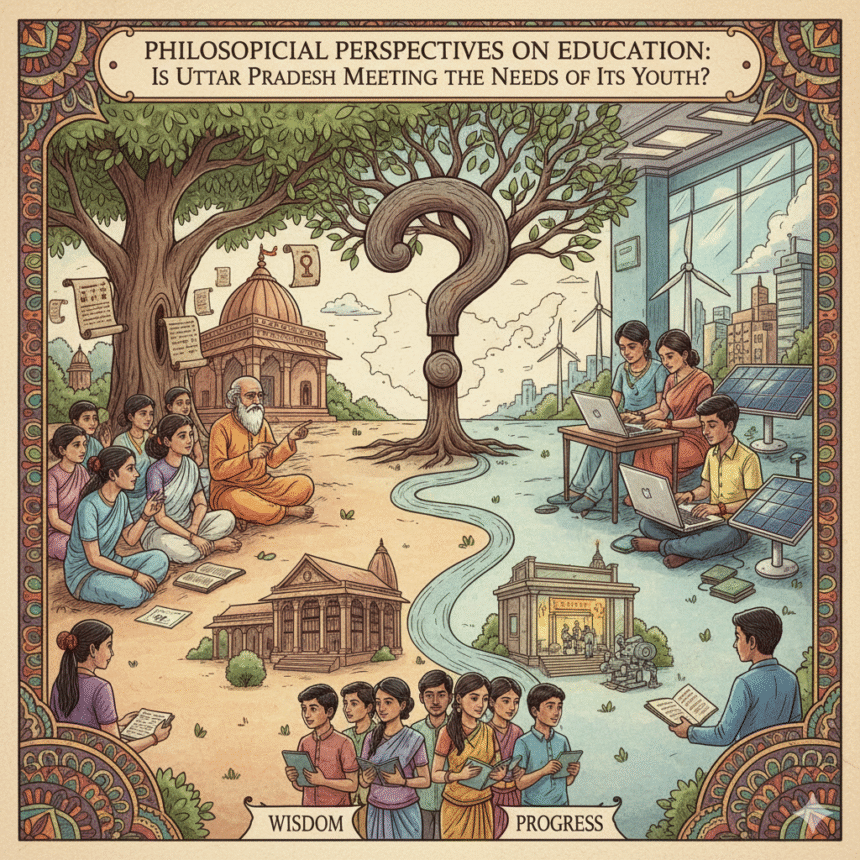Analyzing the Balance Between Tradition and Modernity in Shaping the State’s Educational Future
Lucknow – Uttar Pradesh, the most populous state in India, is at a critical juncture in determining the trajectory of its education system. With a rich philosophical heritage rooted in Vedic teachings, Gandhian ideals, and Ambedkarite principles of equality, the state’s education system must balance tradition with the demands of a rapidly modernizing world. But is Uttar Pradesh truly meeting the needs of its youth, or are there gaps that still need to be bridged?
Key Metrics
- Youth Population: Uttar Pradesh has over 35% of its population aged 15-35, making it imperative for the state to focus on education reform (Census 2011).
- Literacy Rate: The state’s literacy rate stands at 73%, below the national average of 77.7% (Census Data).
- Digital Access: Through the Digi Shakti Program, over 50 lakh students have received tablets and smartphones, promoting digital learning (UP Government Report, 2023).
- Skill Development: Under Skill India, Uttar Pradesh has trained more than 2 million youth, addressing employability gaps (Ministry of Skill Development).
Philosophical Foundations of Education in Uttar Pradesh
1. Vedic Traditions and Holistic Learning
Ancient Vedic teachings emphasize education as a path to holistic development, integrating moral, spiritual, and intellectual growth.
- Modern Relevance: Programs integrating yoga and value-based education reflect this heritage, fostering a balance between physical well-being and ethical grounding.
- Example: Schools in Varanasi and Ayodhya have introduced courses on the Bhagavad Gita and Vedic mathematics.
2. Gandhian Principles of Nai Talim
Mahatma Gandhi’s concept of Basic Education emphasized practical learning and self-reliance.
- Application Today: Vocational training and community-based projects in rural Uttar Pradesh aim to instill these values, preparing youth for real-world challenges.
3. Ambedkarite Philosophy and Social Equality
Dr. B.R. Ambedkar advocated for education as a means of empowerment, particularly for marginalized communities.
- Current Impact: Reservation policies and scholarship programs for Scheduled Castes and Scheduled Tribes reflect these ideals, though implementation gaps persist.
Contemporary Challenges in Education
1. Access and Infrastructure
- Data Insight: Over 40% of schools in rural Uttar Pradesh still lack basic facilities like toilets and drinking water (ASER Report 2022).
- Impact: Inadequate infrastructure discourages attendance, particularly among girls, affecting enrollment rates.
2. Digital Divide
While initiatives like Digi Shakti have expanded digital learning, rural areas still face connectivity and accessibility issues.
- Example: Only 38% of rural households have access to the internet, compared to 68% in urban areas (TRAI Reports, 2023).
3. Curriculum Limitations
The state’s focus on rote learning hinders creativity, critical thinking, and problem-solving skills among students.
- Employability Concern: A 2023 survey found that only 47% of graduates in Uttar Pradesh were employable in industry roles (India Skills Report).
Government Initiatives and Reforms
1. Digi Shakti Program
This initiative provides digital devices to students, enabling them to access online resources and bridge the learning gap.
2. Operation Kayakalp
Focused on improving school infrastructure, the program has transformed over 40,000 schools with better classrooms and sanitation facilities.
3. NEP 2020 Implementation
The state has aligned its education system with the National Education Policy 2020, emphasizing skill-based learning, multilingual education, and holistic development.
4. Skill Development Initiatives
Programs like Skill India and PMKVY have trained youth in various trades, aiming to create a job-ready workforce.
Philosophical Reflections for Future Growth
1. Embracing Holistic Education
Drawing from Vedic traditions, education in Uttar Pradesh should focus on developing students’ intellectual, emotional, and moral faculties.
2. Equality in Education
Ambedkarite ideals demand a stronger focus on inclusivity, ensuring marginalized communities receive equal access to quality education.
3. Balancing Tradition and Innovation
Blending traditional knowledge with modern pedagogical methods can prepare students for the global stage without losing their cultural identity.
Pathways to Improvement
- Infrastructure Development
- Expand initiatives like Operation Kayakalp to ensure all schools have adequate facilities.
- Bridging the Digital Divide
- Invest in internet connectivity for rural areas and provide training for teachers in digital education methods.
- Curriculum Revamp
- Introduce experiential and project-based learning to encourage critical thinking and creativity.
- Vocational Training Expansion
- Broaden the scope of skill development programs to include emerging fields like artificial intelligence, green energy, and healthcare.
Conclusion
Uttar Pradesh’s education system is a reflection of its philosophical heritage and modern aspirations. While significant progress has been made, challenges like infrastructure deficits, the digital divide, and outdated curricula need urgent attention.
By embracing its rich traditions and integrating them with contemporary reforms, Uttar Pradesh can create an education system that truly meets the needs of its youth, preparing them to lead India into the future.


Leave a Reply